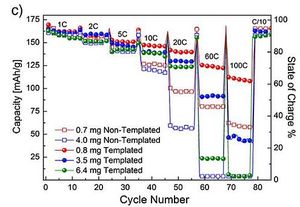Research
Large Scale Electricity Storage
The increasing implementation of renewable electricity generation in the form of solar power and wind power leads to increasing intermittence of the electricity generation. In the European Union the CO2 emission is to be reduced by 80% in 2050 (with respect to 1990), while in the Netherlands a more strict goal of 95% reduction is planned; which means a massive implementation of renewables and CO2 neutral technologies. It can be shown that the renewables implementation results in systematic daily and seasonal variation of renewable power. Solar power and wind power both peak at daytime and diminish at night. Solar power in the Netherlands is 6 times stronger in summer than in winter while wind power is about 2 times stronger in winter than in summer.
The combined generation of solar and wind power on an extended electricity grid needs to be matched by the total demand and intermediate electricity storage. Storage on both daily and seasonal timescales are necessary to match supply and demand 24h/365d of the year. Typical scales are up to EJ for short term storage worldwide and many tens of EJ for long term storage by 2050.

Green: possible output of solar and wind power on a large scale grid with ~30% renewable energy use. Blue: possible electricity use pattern in a progressively electrified society. Black: short term day/night storage. Red: long term seasonal storage. Info in J. Renewable Sustainable Energy 6, 033105 (2014)
Large scale solutions for electricity storage
- Ammonia (NH3) as energy storage, energy density: 6.5 kWh/kg.
- Hydrogen generation and storage.
- High energy density Li and Na-ion batteries, energy density: 100 – 400 Wh/kg.
- Hydrogen based batteries: light metal hydrides for Ni-MH batteries, Ni-Fe batteries with very long lifetime.
-
Goal:Enabling more efficient synthesis of ammonia using electrochemical methods and abundant catalysts. The rationale for using ammonia as energy store is given below: it provides a high energy density liquid energy store based on abundant elements that will remain abundant in the future. Ammonia can be used as fuel in various ways including fuel cells and gas turbines.

-
Goal:Understand and develop materials that can store and release larger weight fractions of hydrogen in abundant materials, at as close to ambient conditions as possible. The alterations of thermodynamic factors by nanostructuring as well as interface effects on the transport of hydrogen are part of the research. Materials are synthesized by various techniques including spark discharge generation, mechanical alloying and chemical synthesis.
Examples:


Nanostructured metal hydrides (left) can show largely modified thermodynamics (middle) and so called entropy-enthalpy compensation effects (right).

Stabilisation of metal organic frameworks against humidity can be realised by hydrophobic side groups on the benzene linkers. This is of importance for H2 storage and separation from gas streams.
Key papers:
- Reduced enthalpy of metal hydride formation for Mg-Ti nanocomposites produced by spark discharge generation
- Extended Solubility Limits and Nanograin Refinement in Ti/Zr Fluoride-Catalyzed MgH2
- <annref idrefs="ann1">Methyl</annref> modified MOF-5: a water stable hydrogen storage material
- Large Space-Charge Effects in a Nanostructured Proton Conductor
- Hysteresis and the role of nucleation and growth in the hydrogenation of Mg nanolayers
- Nucleation and growth mechanisms of nano <compname idrefs="chem1">magnesium hydride</compname> from the hydrogen sorption kinetics
- Probing hydrogen spillover in Pd@MIL-101(Cr) with a focus on hydrogen chemisorption
-
Goal:Understanding of the storage and release of Li and Na in high energy density storage materials and in the storage electrodes built from them.
Example:

Suitable nanostructured electrode materials are capable of reaching high charge rates, but only structured (templated) electrodes in batteries appear to be able to support the ionic and electronic transport in realistic, thick, electrodes (in collaboration with RST,TNW)
Key papers:
- Properties and promises of Nanosized Insertion Materials for Li-Ion Batteries
- Facile Micro Templating LiFePO4 Electrodes for High Performance Li-Ion Batteries
- F.M. Mulder, M. Wagemaker, Electrode assembly for a lithium ion battery, process for the production of such electrode assembly, and lithium ion battery comprising such electrode assemblies. WO Patent 2,013,012,334
- Size Effects in the Li4+xTi5O12 Spinel
-
Goal:Ni-metal hydride batteries and Ni-Fe batteries have the Ni(OH)2 as hydrogen storage cathode material in common. The anodes are different, and the goal is to develop more durable anodes based on abundant elements.
Projects:
- Nanostructured and catalysed MgH2 as anode for Ni-MH batteries (ADEM). Replacing the currently used LaNi5 type material is a long standing challenge. Since novel catalysed Mg based materials can now store hydrogen at RT this opens the possibility for their utilisation as abundant material - high capacity anode. Challenges are in the field of electrolyte – electrode interactions.
- A modified Ni-Fe battery with reduced cost Fe based anode (STW Valorisation grants 1&2). The longevity of Ni-Fe batteries first developed by Edison is well known. It is anticipated that this may provide a large scale, static, electricity storage solution. The project concerns the development of the battery with a novel Fe based anode which is more cost effective and efficient, and suppresses unwanted hydrogen and oxygen evolution from the aqueous electrolyte.